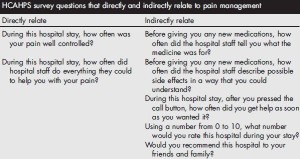Despite previously published guidelines and practice recommendations, there remains unwarranted variation in the quality of pain management provided to patients having surgery. Unwarranted variations in healthcare are inconsistencies in clinical practice that have no basis in science or patient preference.
In 2019, the U.S. Health and Human Services (HHS) Pain Management Best Practices Inter-Agency Task Force published its report, which called on medical societies to work together to develop evidence-based guidelines to improve the quality of pain care delivery. The Task Force, which was Chaired by Stanford anesthesiology and pain medicine specialist Dr. Vanila Singh when she was Chief Medical Officer of HSS, recommended individualized, multimodal, and multidisciplinary approaches to pain management to help decrease an over-reliance on opioids, increase access to care, and promote widespread education on pain and substance use disorders.
Following the release of this Task Force report, leaders of the American Society of Anesthesiologists (ASA) decided to take action and launched a 2-year project. As Chair of the ASA Committee on Regional Anesthesia and Pain Medicine, I participated as a member of the steering committee and served as Co-Chair of the Pain Summit. ASA invited 13 other medical societies to join a new consortium dedicated to improving pain management (in alphabetical order):
- American Academy of Orthopaedic Surgeons
- American Academy of Otolaryngology-Head and Neck Surgery
- American Association of Neurological Surgeons
- American Association of Oral and Maxillofacial Surgeons
- American College of Obstetricians and Gynecologists
- American College of Surgeons
- American Hospital Association
- American Medical Association
- American Society of Breast Surgeons
- American Society of Plastic Surgeons
- American Society of Regional Anesthesia and Pain Medicine
- American Urological Association
- Society of Thoracic Surgeons
For its first initiative, the consortium agreed to focus on the pain care of the routine, non-complex (i.e., opioid-naïve) adult surgical patient. Over the course of several months, using Delphi methodology and culminating in the first live virtual Pain Summit involving all participating societies, this multiorganizational consensus process resulted in the establishment of 7 guiding principles for acute perioperative pain management.
Now published in Regional Anesthesia & Pain Medicine, these principles are intended to help healthcare systems and individual clinicians provide better care for patients having surgery. These principles include the need for preoperative evaluation of medical and psychological conditions and potential substance use disorders, a focus on multimodal analgesia including nonpharmacologic interventions, use of validated pain assessment tools to guide and adjust treatment, and the importance of individualized care and education, among others.
The final seven principles are:
- Clinicians should conduct a preoperative evaluation including assessment of medical and psychological conditions, concomitant medications, history of chronic pain, substance use disorder, and previous postoperative treatment regimens and responses, to guide the perioperative pain management plan.
- Clinicians should use a validated pain assessment tool to track responses to postoperative pain treatments and adjust treatment plans accordingly.
- Clinicians should offer multimodal analgesia, or the use of a variety of analgesic medications and techniques combined with nonpharmacological interventions, for the treatment of postoperative pain in adults.
- Clinicians should provide patient and family-centered, individually tailored education to the patient (and/or responsible caregiver), including information on treatment options for managing postoperative pain, and document the plan and goals for postoperative pain management.
- Clinicians should provide education to all patients (adult) and primary caregivers on the pain treatment plan, including proper storage and disposal of opioids and tapering of analgesics after hospital discharge.
- Clinicians should adjust the pain management plan based on adequacy of pain relief and presence of adverse events.
- Clinicians should have access to consultation with a pain specialist for patients who have inadequately controlled postoperative pain or are at high risk of inadequately controlled postoperative pain at their facilities (e.g., long-term opioid therapy, history of substance use disorder).
The formation of this consortium is a critical first step to widespread quality improvement in perioperative pain management for surgical patients across the country. The fact that 14 professional healthcare organizations could agree on these 7 principles means that the bar for acute perioperative pain management has been reset.
The work product of this consortium can now form the basis of all future guidelines and influence the products of legislation and regulation that affect pain management for surgical patients. There is still so much work to do, however, and this consortium is already looking at how to tailor these principles to more complex surgical populations, better assess barriers to change implementation, and provide each organization’s members with the tools they need to improve acute perioperative pain management where they are.




 We all know that not all pain is the same. While chronic pain can sometimes be palliated,
We all know that not all pain is the same. While chronic pain can sometimes be palliated, 
